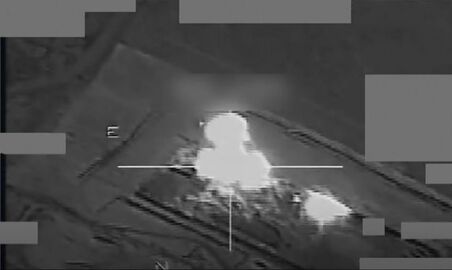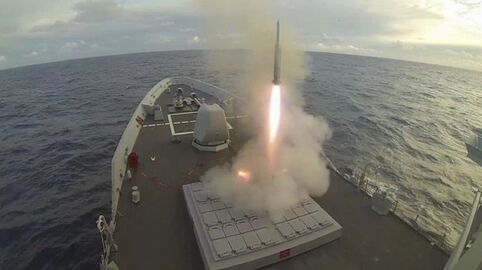Akanatoa War
The Akanatoa is an ongoing military conflict between Pelaxia, Loa Republic and the Akanatoa Chiefdom.
| Akanatoa War | |||||||
|---|---|---|---|---|---|---|---|
| Part of Loa Civil War of 2026 | |||||||
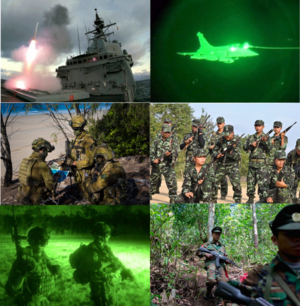 Akanatoa War | |||||||
| |||||||
| Belligerents | |||||||
| Commanders and leaders | |||||||
| |||||||
Background
The Akanatoa Chiefdom has been linked with Pelaxian local terrorist and separatist organization from the province of Savria. Under the perview of E4 commitments Pelaxia has been carrying out counter-smuggling operations over the Kindred Sea to deny Loa smugglers free movement in the sea and prevent them from smuggling weapons into Pelaxia.
The Pelaxian Ministry of Defense produced an extensive intelligence report linking the smuggling activities to the High Chieftain Galauenda of Akanatoa. Through this, the Federal Chancellor Valladolid instructed its Primer Minister, Pedro Meireles, to carry out the arrest and/or elimination of the responsible groups devicing this activities.
Outbreak

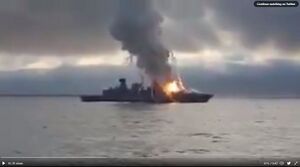
On January 2026 two "Guardia Civil" officers were shot and killed at a checkpoint 10 kilometers away from Leg in Savria. These attacks were claimed but the re-formed separatist organizartion FLNS. During the month of January and February, Federal Civil Guard elements cracked down on the attackers. Guardia Civil's presence in Savria and its capital Tabăra was to be reinforced as provincial elections approached. Meireles' reportedly snapped at the Joint Chiefs of Staff "No Fuckery" around the Operation Mare Nostrum, reported RMC News.
From the operartion carried out by the Guardia Civil, it was alleged that the guns used by the FLNS have not been funneled from within Anastasio Torque Autonomous Community, and later the Minisitry of Interior, Ministry of Security and the DISEN were instructed to elaborate a comprehensive report on the matter. This report, later titled the "Weapons Lane " report detailed a connection bettween high ranking chiefs of the Akanatoa region and FLNS militants.
Primer Minister Meireles lauched Operation "Mare Nostrum" through national security powers. Naval elements expaned its area of operation and assets in the Kindred Sea to police and secure maritime lanes under the E4 perview and capacity. "This a direct response to the pressure he is handling after the arms smuggling in Sawra" , a Government insider said at the time. This marked the first time a Prime Minister made use of the Smart Defense Act, which gives the Prime Minister powers for emergency military deployment abroad and support of federal forces internally by declaring a state of exception in the event of an explicit threat to national security, if the Chiefdom of the Akanatoa Ipadoes does not extradite regional leaders implicated by the Ministry of Interior in the "Weapons Lane" Report. Political advisors and Chiefs of Staff were described as "uneasy" by a source.
By late february a large concentration of pelaxian military assets on key strategic naval bases and ports was noticeable by several media outlets and even several family members of pelaxian service men went on social media expressing concrerns for their relatives being called upong to their bases.
On March 20th, the Ministry of Defense reported 1 dead and 2 injured during and attack to a Pelaxian frigate. The Pelaxian Navy confirmed the Gutierrez Class Frigate "NAP Aureliano Castro" was impacted by a weapons smuggling boat loaded with explosives, as a second boat avoided the patrol task force. "This shows an upgrade in Loa smuggling tactics who are willing to target military and security personell in the Kindred", the Navy report said. From the images shared on Ixtwitter, the explosion triggered an on deck fire and fire protocols were initiated. One sailor was confirmed deceased on board, while another two were injured
Later that month in Loa, the invasion of Lepekepeke has advanced significantly, with the entire eastern half of the itisi being occupied bu the joint forces of Huselesele and Kasanda. The Queen Mother of Jateatea Koaualolo later made an official statement. She stated that the Kingdoms Jateatea, Gokulu and Hasada will intervene militarily against the two invasions, and that Jateatea will be sending approximately 30,000 troops to pacify the Ahoso Rebellions. In addition, the Queen Mother as reportedly allowed the state of Pelaxia to assist in the matter. Although the combined forces of the three kingdoms numbers 700,000 their military is far less disciplined and well supplied then the kapo, who are by nature warmongering.
By March 2026 full mobilization was issued to the Pelaxian Armed Forces, and by May Operacion Cimitarra was approved.
Operación Cimitarra
Galauenda Raid

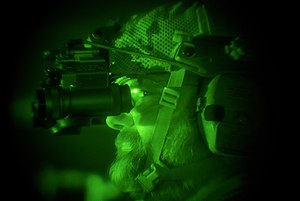
On March 13th, two battalions of the 1st Pioneers Regiment ("Pioneros") and one company of the 1st Rapid Aerial Response Battalion (1st RAR) landed on Akanatoan territory by a swimmer delivery vehicle and inflatable boats under cover of the night. Their mission was to kill or capture Chieftain Galauenda and other 5 of his generals. The Pioneers were to screen and gather intelligence on the military capacity of the Akanatoan forces around Imahenda and to track the movements of Galauenda, awaiting approval to strike. The combined special operations task force was instructed to create and secure a supply landing zone to substain them vía nocturnal air drop from an A-400M.
On the night of March 31st Operación Cimitarra is green lit and the company of the 1st RAR engages Galauenda’s escort convoy 30 kilometers away from Imahenda. The Ministry of Defense will later report that 3 members of the High Chieftain of Akanatoa General Staff have been killed during an operation carried by the 1st Rapid Aerial Response Battalion (1st RAR) that has been deployed over the region in advance of Operation Cimitarra.
Afterwards 1st RAR was to continue gathering intelligence on key strategic objectives such as ammo depots, radio towers and anti-air positions and secure a supply landing zone for the rest of the special forces in the area. While the 1st Pioneers Regiment were tasked to destroy already marked installations such as radar instalations. The intelligence and marking of objetctived carried out by the Pioneers and the 1st RAR would be key to the following SEAD operation carried out by the Pelaxian Navy and its air assets.
Sea and Air Operations
On the 1st of April the Pelaxian Task Force already lurking in the Akanatoan waters started its SEAD operations to destroy or deny the enemy infrastructure and establish a No Fly Zone over Akanatoa for the following land campaign.
The maritime task force was composed of
- 2 aircraft carriers,
- 20 frigates,
- 4 submarines,
- 30 corvettes,
- 8 Amphibious transport docks and
- 2 landing ship tanks.
-
Jerónimo I being scorted
-
Rafale M takes off on a bombing mission.
-
Akanatoan ammo depot being hit.
-
Pelaxian navy frigate Hugo Charpantier engaging a hostile aircraft.
Together this fleet amassed a force of 160,000 personnel of the Pelaxian Armed Forces and the Federal Civil Guard.
Air raids from the Enterprise Class "Jernónimo l" aircraft carrier began in the morning with Burgundian Rafale M and Urcean F4 Phantoms, making up to 40 sorties per day engaging several ground objectives identified by the special forces on the ground. As per maritime strategy the frigate escort provided anti air protection to the carriers, engaging several Akanatoan small aircraft that threatened the operation of the task force.
By the 10th of April nearly all the stationary and logistical reserves of the Akanatoan militia has been destroyed, and the Task Force controlled the airspace over the province.
Ground Operation
First Amphibious Operation
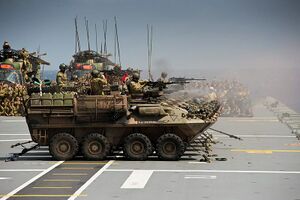
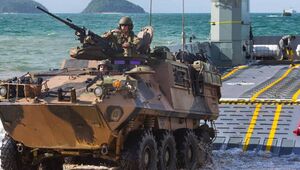
A heavy land base of operations was key for the following land invasion of Operación Cimitarra. The lack of this base would compromise any big land unit that intended to operate in mainland Akanaoa. Eventually a plan was hatched to capture the Prima Island right off the coast of the Imahenda delta. The plan was to carry out an amphibious landing by Pelaxian Marine forces the 12th of April, eject the small Akanatoan presence and establish an airbase on the island.
The success of this operation would depend on the performance of the Pelaxian Marine Corps whose task was to get ashore and physically capture the Akanatoan garrison.
Following the capture of Prima Island, Base Irunga began construction as the main operating base for the combined Pelaxian forces, and to become the biggest foreign operating base of the Pelaxian Armed Forces to date.
Base Irunga would be the seat of the theater command for the rest of the operation.
Airborne Deployment in the North
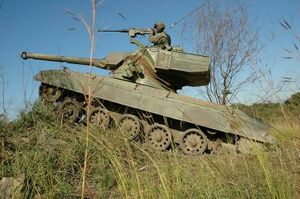
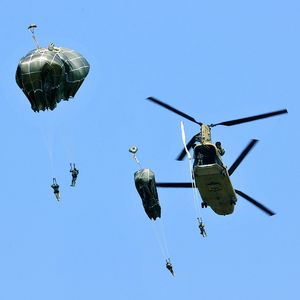
The 813th Air Recon Battalion embarked on CH - 47s and Aérospatiale SA 330 Pumas to perform an air assault landing on Sulaga city, intending to land in the mountains, secure a strategic airfield 10 kilometers from the area to channel in reinforcements and begin to surround the city. This key airfield was nicknamed “La pista de oro” / “The golden strip” some platoons had to switch abruptly to a parachute landing when they learned mid-flight that some landing zones were contested. The air drop began at 03:30 on April 13th in the face of heavy resistance from anti-aircraft guns and several small arms fire. Dassault Rafale M provided support for the landing.
Local construction vehicles were commandeered to help clear landing zones and roads, and one even used to provide mobile cover for the troopers as they moved to seize the heights surrounding the roads.The troopers secured several road junctions and bridges leading to the city by 08:00 AM, and transport planes were able to land and unload additional reinforcements.
By 10:00 “The golden strip” was secured enabling Airbus A400-M to land several SK-105 tank destroyers to provide fire support for the following troops. Starting at 12:00, troops began landing from the 801st and 802nd Parachute Regiments. Troopers from the 813th fanned out and secured the surrounding area, negotiating the surrender of over 300 Akanatoans in an aviation hangar.
At 15:30, major firefights were reported as local militia started counter-attacking.
Marine landing at Banaluekono
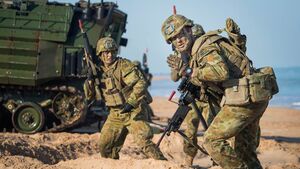
On April 20th the NAP Enrico, Unión, and Laureano, carrying the 1st Marine Expeditionary Legion under Condestable General Carlos Algabo, deploy the spearhead of the naval infantry operation on the city of Banaluekono, 20 kilometeres away from Imahenda.
First ashore was the Battalion Landing Team 3/9, which arrived on the beach at 8:15 a.m. Wearing full battle gear and carrying RAP-18s, the Marines were met with small arms fire on the beach. Within two hours, Battalion Landing Team 1/3 began landing.
The 7,000 Marines were deployed to secure the town’s airstrip, freeing local rebel militia up for combat. The Marines successfully create a secure beachhead for the rest of the Division, in order to create a second front West of Imahenda and advance north cutting off any Akanatoan forces trying to run into friendly provinces.
Battle of Imahenda
Preparations
Before beginning their attack, Pelaxian special forces had established checkpoints around the city to prevent anyone from entering, and to intercept enemy fighters attempting to flee. In addition, overhead imagery was used to prepare maps of the city for use by the attackers. Pelaxian units were augmented by Loa local interpreters to assist them in the planned fight. After weeks of withstanding air strikes and artillery bombardment, the Akanatoan fighters in the city appeared to be vulnerable to direct attack. Pelaxian Army, Marines, Navy and Special Forces totalled 71,200. The Pelaxian High Command had gathered a complete Marine division of 20,000 and two Army division of 51,600 soldiers that would take part in the assault, with about 2,500 Navy and Special Forces personnel in operational and support roles.
Troops were grouped in three Divisions comprising the "Cuerpo de Armas Combinadas de Imahenda" (Imahenda Combined Arms Corps)
2nd Marine Division
'2nd Expeditionary Legion
- 1st Mechanized Marine Regiment
- 2nd Marine Regiment
- 2nd Mechanized Marine Regiment
- 4th Marine Regiment
- 5th Marine Regiment
- 6th Marine Regiment
- 2nd Marine Artillery Regiment
- 3rd Marine Logistics Regiment
- 4th Marine Logistics Regiment
- 2nd Marine Engineer Regiment
- 3rd Marine Engineer Regiment
1st Army Division
1st Infantry Legion
- 45th Termian Regiment
- 1st Air Cavalry Regiment
- 15th Artillery Batallion
- 134th Air Defence Batallion
- 33rd Engineer Batallion
- 35th Comms Batallion
- 54th Logistics Regiment
- 1st Medical Batallion
1st Mechanized Birgade
- 61st Dragoons Regiment
- 142nd Mech. Infrantry Regiment
- 92nd Artillery Batallion
- 7th Air Defence Batallion
- 34th Engineer Batallion
- 36th Comms Batallion
- 55th Logistics Regiment
- 2nd Medical Batallion
1st Armor Birgade
- 1st Armored Cavalry Batallion
- 143rd Mech. Infrantry Regiment
- 2nd Artillery Regiment
- 40th Air Defence Regiment
- 12th Engineer Batallion
- 13th Engineer Batallion
- 75th Engineer Batallion
- 37th Comms Batallion
3rd Army Division
3rd Infantry Legion
- 44th Infantry Regiment
- 135th Air Defence Batallion
- 33rd Engineer Batallion
- 35th Comms Batallion
- 60th Logistics Regiment
- 1st Tactical Air Transport Squadron
- 7th Medical Batallion
4th Infantry Legion
- 14th Motorized Infantry Regiment
- 5th Artillery Batallion
- 9th Air Defence Batallion
- 37th Engineer Batallion
- 41st Comms Batallion
- 61st Logistics Regiment
- 8th Medical Batallion
Special Forces Attachment
- 1st Rapid Aerial Response Batallion (1st RAR)
- 1st Halberd Legion Regiment (1st RAL)
All the BOCs were supported by Marine fixed and rotary-winged aircraft, Navy and Air Force fixed-wing aircraft; 1st Rapid Aerial Response Batallion (1st RAR) teams, 1st Halberd Legion Regiment (1st RAL) battalions and corresponding units from the Logistics and Medical Common Corps.
The 1st Rapid Aerial Response Batallion (1st RAR) was ordered to help with the encirclement of Imahenda. As part of the support elements (TBD Unit from Arcerion) prepared to take part in the operation.
Akanatoan Forces
Imahenda was defended by about 15,000 "regulars" and 5,000+ "part time" conmbatants. Imahenda was occupied by virtually every military unit from the Akanatoan Ipa: TBD,TBD,TBD,TBD.
The Akanatoan forces present in the city prepared fortified defenses in advance of the anticipated attack. They dug tunnels, trenches, prepared spider holes, and built and hid a wide variety of IEDs. In some locations they filled the interiors of darkened homes with large numbers of propane bottles, large drums of gasoline, and ordnance, all wired to a remote trigger that could be set off when troops entered the building. They blocked streets with Jersey barriers and even emplaced them within homes to create strong points behind which they could attack unsuspecting troops entering the building.
The Akanatoan forces were equipped with a variety of advanced small arms, APCs, trucks, body armor, uniforms and helmets. They booby-trapped buildings and vehicles, including wiring doors and windows to grenades and other ordnance. Anticipating tactics to seize the roof of high buildings, they bricked up stairwells to the roofs of many buildings, creating paths into prepared fields of fire which they hoped the troops would enter.
Intelligence briefings given prior to battle reported that Pelaxian forces would encounter Istrenyan, and Daxian combatants, as well as native Akanatoans.
Phase 1
Special Forces Attachment secures Gulf Island: Both the Pelaxian 1st Rapid Aerial Response Batallion (1st RAR) and the Arco Commando served as the main effort on the island and supported by the 1st Halberd Legion Regiment (1st RAL). These initial attacks, however, were aimed to secure access to the city’s gulf and establish a base for artillery and forward command posts on the small island covering the mouth of the river.
The island was mainly unguarded with only small groups of armed akanatoan militias. A special force attachment was trusted with this operation in order to minimize collateral damage to sacred and holy places that were present all over the territory. 1st RAR landed at 11.00 and around 13.00 the 1st RAL encountered small arms fire that was quickly taken care of. By 15.00 the whole island was considered secured and no damages to holy structures were reported.
The island would be used as a base for command and support units following the next phase of the invasion. Artillery units began to be air dropped by 16.00 and by 20.00 a Forward Operating Base was under construction.
-
Phase 1": Pelaxian and Arco Special Forces Attachment
-
Phase 2 and 3 in tandem
-
The beginning of Phase 2: the 2nd Marine Division moving along the river
Phase 2
After the 2nd Marine Engineer Regiment interrupted and disabled electrical power at two substations located just northeast and northwest of the city. At the same time, one batallion of the 1st Halberd Legion Regiment (1st RAL) secured the electrical power station southwest of the city.
Once the main special forces elements have secured these key infrasatructure, the 2nd Expeditionary Legion of the 2nd Marine Division launched an attack along the southern coast of the city, right over the industrial sector. The marines were to clear the initial landing site in order to spearhead the advance over the key industrial sector of the city. Advancing north and following the river on both the west and east bank, their objective was to clear the industrial sector of any enemy presence and secure three bridges for later demolition. The destruction of the bridges would pocket any Akanatoan forces east of the river.
Phase 3: 3rd Army Division Lands
After securing the electrical power stations and clearing the initial landing site, the 2nd Expeditionary Legion of the 2nd Marine Division advanced north along the river to secure the key industrial sector of the city. Their objective was to clear the area of any enemy presence and secure three bridges for later demolition, in order to trap any Akanatoan forces east of the river.
Meanwhile, the 3rd Army Division was preparing to launch a strategic operation to further reinforce the Pelaxian apmhibious operation. They landed on the main port area of the capital, with the mission to secure both banks of the port area united by the main bridge, and then link up with the 2nd Marine Division and relieve them as an in-depth landing force. The 3rd Army Division brought in additional troops and equipment to bolster the Pelaxian landing in the city. They secured the southern flank of the operation and coordinated with the 2nd Marine Division to continue the advance towards the city's business sector. Despite facing stiff resistance from Akanatoan forces, the Pelaxian military's strategic planning and well-coordinated operations enabled them to make steady progress towards achieving their objectives. With the arrival of the 3rd Army Division, the Pelaxian military's position in the city was further strengthened, giving them a significant advantage in the ongoing battle.
In addition to reinforcing the Pelaxian military's position in the city, the 3rd Army Division had a final objective to advance towards the key governmental buildings in the city, advancing through the business sector first. This was a critical target that needed to be secured in order to gain control of the city and establish a strong foothold for future operations. The 3rd Army Division began their advance towards the governmental buildings, coordinating closely with the 2nd Marine Division and other special forces units in the outskirts of the city. They faced stiff resistance from Akanatoan forces who were fiercely defending their capital city, but the Pelaxian military's well-coordinated operations enabled them to steadily push forward towards their objectives.
With the support of air and artillery units, the 3rd Army Division made significant progress towards their objective, securing key positions and eliminating enemy resistance along the way, while at the same time sustaining heavy loses in equipment and manpower due to less than adequate protection for high intensity urban combat. Despite facing difficult conditions, the Pelaxian military's determination and superior tactics enabled them to achieve their objectives and establish a strong foothold in the region.
During the intense combat in the government district, the 3rd Army Division faced heavy engagement both during the day and relentless surprise counterattacks at night. The Akanatoan forces, determined to defend their capital, launched fierce assaults to dislodge the Pelaxian military from their positions. The 3rd Army Division, however, withouth heavy armor support as it did not have a main battle tank suited for intense urban combat, remained resilient and adapted their tactics to effectively respond to these challenges.
One crucial element that proved vital in disrupting enemy resistance and enabling the division to achieve its ground objectives was the close air support provided by a formidable array of aircraft. The Rafale Ms, AV-8A Harriers, and CASA C-101 Aviojets played a pivotal role in delivering airstrikes on enemy strongholds, troop concentrations, and armored assets. These aircraft conducted precision and "area" strikes, obliterating key enemy positions and infrastructure, weakening their defensive capabilities.
Under the cover of darkness, when the Akanatoan forces attempted surprise counterattacks, the Pelaxian military relied on the timely and accurate air support from the aforementioned aircraft. The Rafale Ms, with their advanced sensors and weapons systems, engaged enemy targets with precision-guided munitions, effectively disrupting the enemy's momentum and inflicting significant damage. The AV-8A Harriers, known for their versatility and vertical takeoff capabilities, provided close air support and supply deliveries in this urban environment. Additionally, the CASA C-101 Aviojets, renowned for their agility and firepower, launched coordinated "area" strikes, suppressing enemy movements and providing critical support to ground troops, effectively neutralizing enemy combatants and fortifications
These combined efforts of ground forces and close air support were instrumental in maintaining the momentum of the 3rd Army Division's advance and inflicting heavy losses on the Akanatoan forces. By day, ground troops pushed forward, securing key positions and eliminating enemy resistance with the support of airstrikes. At night, the Pelaxian military effectively disrupted enemy counterattacks through coordinated operations, utilizing the close air support to neutralize threats and maintain control over their gained ground.
Despite the challenges faced and the heavy losses sustained, the 3rd Army Division's unwavering determination, combined with the strategic use of air assets, allowed them to persevere and achieve their objectives in the face of a formidable enemy. Their ability to adapt to changing conditions, exploit opportunities, and leverage their air superiority ultimately proved crucial in establishing a firm foothold and ending the Pelaxian military's campaign in the city.
While most of the fighting subsided by 13 May , the Pelaxian Marines and Special Operations Forces continued to face determined isolated resistance from insurgents hidden throughout the city. By 16 May, after nine days of fighting, the Marine command described the action as mopping up pockets of resistance. Sporadic fighting continued until 23 June.


